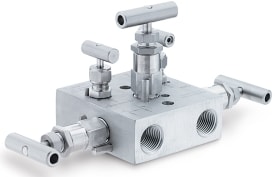Field Report-Transmitter Calibration
Field Report: Transmitter Calibration
Measurement is key to all petrochemical facilities. The accuracy, safety and efficiency of ensuring accurate data is a vital piece of running a responsible operation. Many departments are affected by the reliability of data and key decisions are made continuously to ensure the process meets product specification.
Our customer, one of Alberta’s leading petrochemical producers, invited Swagelok Key Account Manager, Pieter Allan, to work alongside the plant’s Instrumentation department so as to gain a better understanding of the customer’s plant-based applications and business challenges.
Calibration Proves Timely
Transmitters provide data to help measure product specifications in process. Typically, each transmitter is connected to a single valve, single block and bleed, or in the case of a differential pressure application, a 5-way valve. Issues identified by the operations team require an instrument technician to troubleshoot by calibrating the transmitter.
In order for the technician to identify the issue, a series of procedures must occur to lockout and isolate the instrument, including shut off, by operations, of the valve near the process pipe tap. While these procedures increase the delay of diagnosis considerably, they are essential to ensure the safety of plant personnel. The main reason for the bleed valve is to verify the initial block valve is effective in creating a leak tight shut off. Otherwise, unexpected pressure at the instrument creates a very dangerous situation. By bleeding off the pressure after the main block valve, the zero energy or pressure in the line is verified and the diagnosis can continue.
In this case, it was determined that the needle bonnet on the valve was leaking. The replacement was brought in and exchanged. In total, the end-to-end process took over five hours to complete to get the transmitter back online. By explicitly understanding our customer pain point, we were able to immediately work on a solution that would decrease the costly downtime and increase the efficiency of future transmitter calibration.
Challenge Accepted
At Swagelok, we’re constantly being challenged by our customers as they face new challenges in their operation. We’d have it no other way. One of the solutions we presented to our customer was a one-piece, compact double block and bleed valve1. This products affords the instrument technician the ability to perform the double block and bleed at the instrument without needing the shut off at the tap. A pressure line from the tap to the transmitter is typically quite far away and involves multiple departments to lock out. This leads to an increased potential of human error and further delays the diagnosis of the issue. Also, the solution needed to have a calibration port that fit inside the enclosure without adding additional tee fittings.
We were able to provide the one piece valve body containing the double block and bleed, and calibration port. The Swagelok solution was compact enough to fit into the existing enclosure and allows for safe, compact, accurate and efficient maintenance of the critical system.
Measurable Results
The customer is now able to install, replace and repair transmitter applications in a much more efficient way, resulting in a time savings for transmitter diagnosis of more than half the time due to previous facility procedures. There is redundancy in the amount of shut off valves, which adds an additional layer of safety, and previous reliance on the operations department for valve lockout and isolation is greatly reduced resulting in an increase in labour economy.
1When selecting a product, the total system design must be considered to ensure safe, trouble-free performance. Function, material compatibility, adequate ratings, proper installation, operation and maintenance are the responsibilities of the system designer and user.



